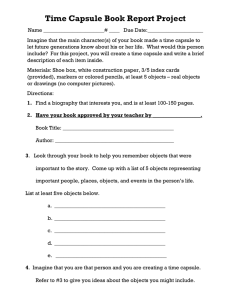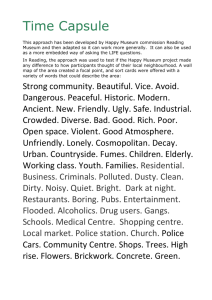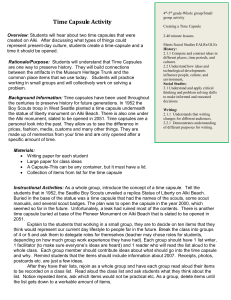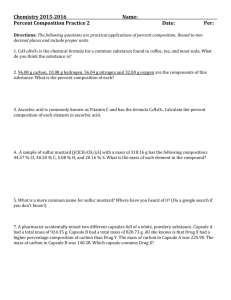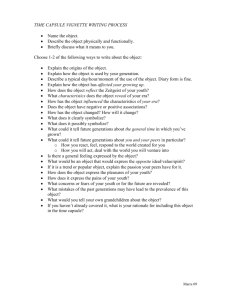Time Capsule
advertisement
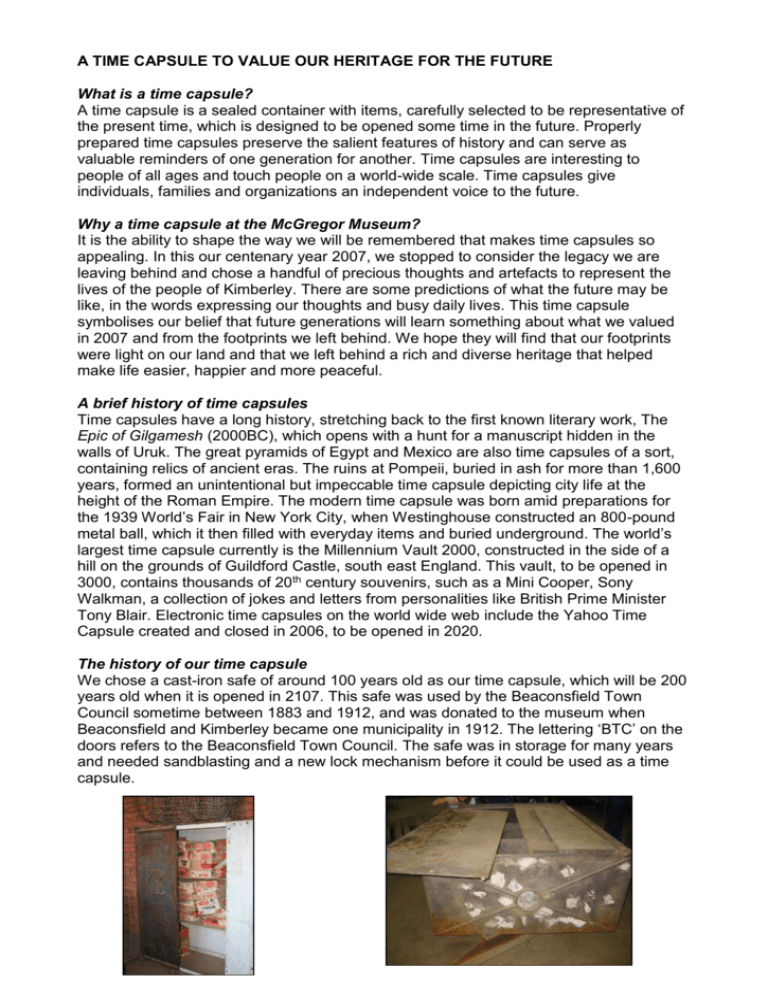
A TIME CAPSULE TO VALUE OUR HERITAGE FOR THE FUTURE What is a time capsule? A time capsule is a sealed container with items, carefully selected to be representative of the present time, which is designed to be opened some time in the future. Properly prepared time capsules preserve the salient features of history and can serve as valuable reminders of one generation for another. Time capsules are interesting to people of all ages and touch people on a world-wide scale. Time capsules give individuals, families and organizations an independent voice to the future. Why a time capsule at the McGregor Museum? It is the ability to shape the way we will be remembered that makes time capsules so appealing. In this our centenary year 2007, we stopped to consider the legacy we are leaving behind and chose a handful of precious thoughts and artefacts to represent the lives of the people of Kimberley. There are some predictions of what the future may be like, in the words expressing our thoughts and busy daily lives. This time capsule symbolises our belief that future generations will learn something about what we valued in 2007 and from the footprints we left behind. We hope they will find that our footprints were light on our land and that we left behind a rich and diverse heritage that helped make life easier, happier and more peaceful. A brief history of time capsules Time capsules have a long history, stretching back to the first known literary work, The Epic of Gilgamesh (2000BC), which opens with a hunt for a manuscript hidden in the walls of Uruk. The great pyramids of Egypt and Mexico are also time capsules of a sort, containing relics of ancient eras. The ruins at Pompeii, buried in ash for more than 1,600 years, formed an unintentional but impeccable time capsule depicting city life at the height of the Roman Empire. The modern time capsule was born amid preparations for the 1939 World’s Fair in New York City, when Westinghouse constructed an 800-pound metal ball, which it then filled with everyday items and buried underground. The world’s largest time capsule currently is the Millennium Vault 2000, constructed in the side of a hill on the grounds of Guildford Castle, south east England. This vault, to be opened in 3000, contains thousands of 20th century souvenirs, such as a Mini Cooper, Sony Walkman, a collection of jokes and letters from personalities like British Prime Minister Tony Blair. Electronic time capsules on the world wide web include the Yahoo Time Capsule created and closed in 2006, to be opened in 2020. The history of our time capsule We chose a cast-iron safe of around 100 years old as our time capsule, which will be 200 years old when it is opened in 2107. This safe was used by the Beaconsfield Town Council sometime between 1883 and 1912, and was donated to the museum when Beaconsfield and Kimberley became one municipality in 1912. The lettering ‘BTC’ on the doors refers to the Beaconsfield Town Council. The safe was in storage for many years and needed sandblasting and a new lock mechanism before it could be used as a time capsule. The safe before renovation (July 2006). The safe in the process of sandblasting (December 2006). The safe being transported to the Alexander McGregor Memorial Museum (July 2007). The De Beers Consolidated Mines Services Department team responsible for repairing and delivering the safe (July 2007). What’s in this time capsule? The people of Kimberley were invited through the media to submit items or their thoughts for the time capsule. The Museum contributed items and articles on important issues in 2007 such as global warming, HIV/AIDS, a cell phone, a book entitled ‘How Cool Stuff Works’, seeds and photos of common and threatened plants of the Kimberley area, environmental education resources such as A year of special days and Envirofacts sheets, a radio, an old spade probably used when the Alexander McGregor Memorial Museum was built, copies of ‘very sensitive’ letters from C.J. Rhodes to F.S. Philipson-Stow (1886-1898), strike action in 2007, advertising brochures and the museum annual report for 2006-2007. A special competition was held to encourage local schools to contribute interesting and creative items. The prize giving took place on 22 June 2007 to hand out 68 prizes to many deserving individuals. Learners from Grades 4 – 10 at the following schools submitted items - Kimberley Girls High, St. Patrick’s College, Kimberley Junior School, !Xunkhwesa Combined School, Adamantia Hoërskool, Diamandveld Laerskool and Diamandveld Hoërskool. Some of the around 100 Items submitted for the time capsule. The Executive Mayor of the Sol Plaatje Municipality wrote a letter for inclusion. Organizations who contributed items include the Wildlife and Environment Society of South Africa (Northern Cape Region), The Africana Library, Cansa, Keep Kimberley Clean, Ekapa Mining, The Big Hole Museum, SwiftPrint, Diamond Pavilion, Kimberley Transport Museum and Mokala National Park. Time Capsule Project Committee The persons responsible for organising and preparing the time capsule were Annemarie van Heerden and Tania Anderson of the Botany Department and Suzanne Erasmus of the Education Department, McGregor Museum. S. Erasmus, A. van Heerden and T. Anderson (left to right, June 2007). With much thanks to our sponsors Mokala National Park Mattanu Game Ranch De Beers Consolidated Mines Services Department The Kimberley Club Diamond Pavilion Defs Engineering, Parsons Home Appliances, Mugg & Bean, MovieZone & Debonairs Pizza. Compiled by T. Anderson For a full list of items List of items in Time Capsule

